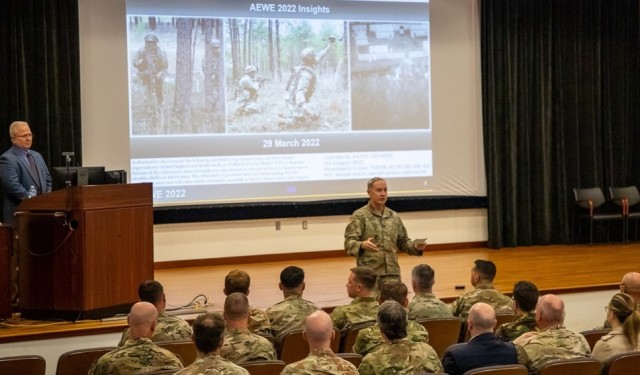
AUSTIN, Texas – Army Expeditionary Warrior Experiment (AEWE) 2022, a four-month endeavor to field-test promising new capabilities and inform requirements for warfighters, wrapped up on Tuesday with an Insights Day that captured progress made and lessons learned.
The outbriefing, attended by Army leaders, Coalition partners, industry experts, academic researchers and defense media, outlined outcomes of the experiment and emphasized the importance of consistent and rigorous Soldier feedback.
AEWE, which is conducted annually at Fort Benning, Georgia, focuses on testing innovations that enable strategic advantages at the Soldier and small unit level, which can then be leveraged to optimize large-scale combat operations.
The event is hosted by the U.S. Army Maneuver Center of Excellence and helps inform the Project Convergence campaign of learning led by U.S. Army Futures Command, as well as other warfighting concepts and materiel development efforts.
Maj. Gen. Patrick J. Donahoe, Commanding General of the U.S. Army Maneuver Center of Excellence and Fort Benning, described AEWE as “a critical, collaborative Army event for testing concepts and equipment to modernize the force.”
“AEWE enables proactive, frequent and iterative Soldier feedback to purposefully inform concepts and technological solutions that significantly reduce operational risk,” Donahoe said.
This year’s experiment marked the 17th iteration of AEWE. The event took 18 months to plan and included the participation of Dutch and British military counterparts.
AEWE 2022 explored multiple priority modernization initiatives, including the use of artificial intelligence and machine learning to reduce cognitive burdens, speed decision-making and enhance threat recognition at the tactical edge. Exercises also informed the Army’s unmanned aircraft systems (UAS) strategy in the critical 2- to 300-meter air space, pinpointing more lethal, survivable and effective combat strategies. The experiment additionally assessed and furthered capabilities related to cross-domain maneuver, autonomous resupply, sensor-to-shooter connectivity, power and energy, and cyber and electromagnetic activities.
Among the 64 technologies evaluated as part of AEWE 2022 were drone swarms, quadruped robots, mobile fuel cells, advanced tactical radios and lasers, intelligent bio-data and human performance trackers and next-generation Soldier health care monitors.
Over the course of the experiment, Soldiers provided detailed and iterative feedback on the effectiveness and ruggedness of new and still-in-development equipment, as well as on the field utility of cutting-edge technologies. The process frequently involved a test-fix-test methodology allowing for the on-site improvement of participating capabilities.

Live fire and simulated operational elements of the experiment provided a cohesive and forward-looking lens through which to observe and plan for future battlefield conditions. Exercises were carried out during daytime and nighttime hours to mimic the scenarios and stress new tools and the Soldiers handling them would likely undergo in a multi-domain conflict with near-peer adversaries. Capabilities examined sought to improve precision of fires, freedom of maneuver, rapid concentration of combat power, positional advantage, threat visualization, operational tempo and unit coordination and resiliency.
The Maneuver Battle Lab reported that experimentation succeeded in demonstrating how advanced sensors can improve situational awareness; how robotic autonomous systems can strengthen mobile intelligence, surveillance and reconnaissance and resupply; and how more adaptive command and control software can increase tactical tempo. The importance of counter-UAS and concealing radio frequencies and other signals from enemy detection was also a key takeaway.
The execution of AEWE 2022 was aided by 38 industry partners and multiple defense organizations and agencies, including U.S. Army Futures Command, the United States Special Operations Command, the Marine Corps Warfighting Lab, the Department of Defense Innovation Unit and the Defense Advanced Research Project Agency.
Numerous Soldiers also participated in the experiment, including members of the U.S. Army’s Alpha Company, 1st Battalion, 29th Infantry Regiment and 6th Squadron, 8th Cavalry Regiment, 2nd Armored Brigade Combat Team, 3rd Infantry Division; the British Army’s Household Cavalry Regiment; and the Royal Netherlands Army’s 13th Light Armored Brigade.


Social Sharing